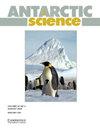Low-temperature investigation of residual water bound in free-living Antarctic Prasiola crispa
IF 2
4区 地球科学
Q3 ENVIRONMENTAL SCIENCES
引用次数: 0
Abstract
Abstract Antarctic algae are extremophilic organisms capable of surviving harsh environmental conditions such as low temperatures and deep dehydration. Although these algae have various adaptations for life in extreme environments, the majority of the molecular mechanisms behind their resistance to dehydration and freezing are not yet fully understood. The aim of our research was to observe the behaviour of bound water freezing in the free-living Antarctic alga Prasiola crispa. One way to avoid frost damage involves deep dehydration of the algal thallus. For that reason, a detailed analysis of water freezing at different sample hydration levels was carried out. Nuclear magnetic resonance investigation revealed two types of water immobilization: cooperative bound water freezing for samples with sample hydration levels above Δm/m0 = 0.40 and non-cooperative bound water immobilization for lower thallus hydration levels. In the differential scanning calorimetry experiment, 2-h incubation at -20°C suggested the diffusion and final binding of supercooled water to the ice nuclei and a lower hydration level threshold, at which ice formation could be observed (Δm/m0 = 0.21). Our research provides a new perspective on water sorption and freezing in Antarctic algae, which may be important not only in biological systems, but also in such novel materials as metal-organic frameworks or covalent organic frameworks.自由生活南极crispa Prasiola残留水界的低温研究
南极藻类是一种极端微生物,能够在低温和深度脱水等恶劣环境条件下生存。尽管这些藻类在极端环境中有各种各样的适应能力,但它们抵抗脱水和冷冻的大部分分子机制尚不完全清楚。我们的研究目的是观察自由生活的南极藻类crispa Prasiola的结合水冻结行为。避免霜冻损害的一种方法是使藻体深度脱水。为此,对不同水化水平下的水冻结进行了详细的分析。核磁共振研究发现两种水固定方式:对水化水平高于Δm/m0 = 0.40的样品进行合作结合水冻结,对水化水平较低的样品进行非合作结合水固定。差示扫描量热实验中,在-20℃条件下孵育2小时,表明过冷水扩散并最终结合到冰核上,并且水化水平阈值较低,可以观察到冰的形成(Δm/m0 = 0.21)。我们的研究为南极藻类的吸附和冻结提供了新的视角,这不仅对生物系统,而且对金属有机框架或共价有机框架等新材料的研究具有重要意义。
本文章由计算机程序翻译,如有差异,请以英文原文为准。
求助全文
约1分钟内获得全文
求助全文
来源期刊

Antarctic Science
地学-地球科学综合
CiteScore
3.60
自引率
6.20%
发文量
42
审稿时长
3 months
期刊介绍:
Antarctic Science provides a truly international forum for the broad spread of studies that increasingly characterise scientific research in the Antarctic. Whilst emphasising interdisciplinary work, the journal publishes papers from environmental management to biodiversity, from volcanoes to icebergs, and from oceanography to the upper atmosphere. No other journal covers such a wide range of Antarctic scientific studies. The journal attracts papers from all countries currently undertaking Antarctic research. It publishes both review and data papers with no limits on length, two-page short notes on technical developments and recent discoveries, and book reviews. These, together with an editorial discussing broader aspects of science, provide a rich and varied mixture of items to interest researchers in all areas of science. There are no page charges, or charges for colour, to authors publishing in the Journal. One issue each year is normally devoted to a specific theme or papers from a major meeting.
 求助内容:
求助内容: 应助结果提醒方式:
应助结果提醒方式:


